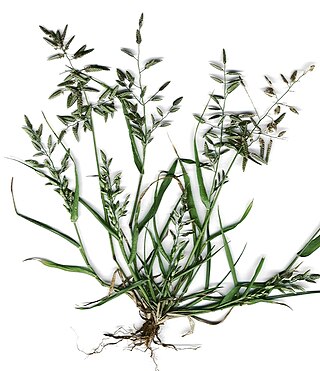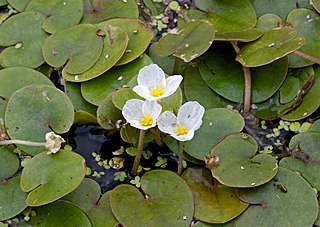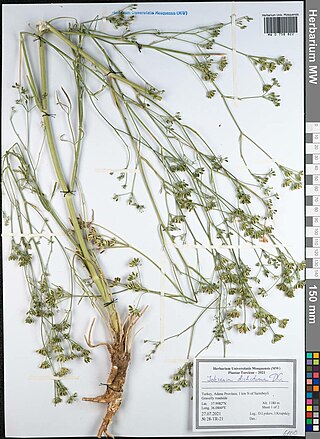
Eragrostis is a large and widespread genus of plants in the grass family, found in many countries on all inhabited continents and many islands.

Hyaenanche globosa is a species of plant under the family Picrodendraceae. It is the sole member of the genus Hyaenanche and the subtribe Hyaenanchinae. It is endemic to Cape Province in South Africa.

Pseudolachnostylis is a genus of plants in the family Phyllanthaceae first described as a genus in 1899. It contains only one known species, Pseudolachnostylis maprouneifolia native to central and southern Africa. Its common name is kudu berry, though the term also applies for Cassine aethiopica. In Zimbabwe it is called mutsonzowa (Shona) or Umqobampunzi (Ndebele).

Acidosasa is a genus of East Asian bamboo in the grass family.

Hydrocharis is a genus of aquatic plants in the family Hydrocharitaceae described as a genus by Carl Linnaeus in 1753. It is widespread across much of Europe and Asia, plus a few scattered locations in Africa. It is also reportedly naturalized in parts of North America.

Anthoxanthum, commonly known as hornworts, vernal grasses, or vernalgrasses, is a genus of plants in the grass family. The generic name means 'Yellow flower' in Botanical Latin, referring to the colour of the mature spikelets.

Thomas Robertson Sim was a botanist, bryologist, botanical artist and Conservator of Forests in Natal, best known for his monumental work The Forests and Forest Flora of the Colony of the Cape of Good Hope which appeared in 1907. He was the eldest of five children of John Sim (1824–1901), a noted bryologist and Isabella Thomson Robertson (1823-).

Halodule is a genus of plants in the family Cymodoceaceae described as a genus in 1841. It is widespread on tropical and semi-tropical ocean shores of all continents except Europe and Antarctica.
Ochthochloa is a genus of desert plants in the grass family native to the Sahara and Arabian Deserts. The only known species is Ochthochloa compressa, whose native range extends from Algeria to Uttarakhand.
Theodor Carl (Karl) Julius Herzog was a German bryologist and phytogeographer. This botanist is denoted by the author abbreviation Herz. when citing a botanical name.

Bridelia micrantha, the mitzeeri or the coastal golden-leaf, is a tree in the family Phyllanthaceae and is native to tropical and southern Africa as well as to the island of Réunion in the Indian Ocean.

Nechamandra is a monotypic genus of an aquatic plant family Hydrocharitaceae. The sole species is Nechamandra alternifolia. It is found in slow moving fresh water.

Jamesbrittenia ramosissima is a Southern African shrub in the family Scrophulariaceae occurring in the Northern Cape and southern Namibia, westward along the Gariep River from the vicinity of Augrabies Falls. It is one of some 90 species in the genus Jamesbrittenia, ranging through Africa, with 74 species occurring in Southern Africa, and 1 in India. The genus is named for James Britten (1846-1924), medical student turned botanist, and acting Keeper of Botany at the British Museum when Kuntze named it.

Ceratocaryum is a group of plants in the Restionaceae described as a genus in 1836. The entire genus is endemic to Cape Province in South Africa.

Vitellariopsis marginata is a species of plant in the family Sapotaceae. It is a shrub or tree native to Mozambique, South Africa, and Eswatini.

Pleea is a small genus of flowering plants described as a genus in 1803. There is only one known species, Pleea tenuifolia, the rush featherling, native to the southeastern United States.

Allophylus decipiens (E.Mey.) Radlk., commonly known as the bastard taaibos, is a multi- or single-stemmed, small, evergreen tree about 3–4 m in height occurring in coastal forest, fringe forest and thickets, and wooded ravines and streams. Found up to 800 m in the southern coastal regions of the Cape Province, KwaZulu-Natal, Eswatini, along the escarpment forest of Mpumalanga, including Soutpansberg and in Mozambique. There are some 219 species in the genus of Allophylus.
Prunus subcorymbosa is a species of tree in the family Rosaceae, and is native to montane forests from Costa Rica, Central America, to Venezuela and northern Peru, South America.

Johrenia is a genus of herbaceous plants of the family Apiaceae.

Hippobromus is a genus of flowering plants belonging to the family Sapindaceae. Its native range is Southern Africa. The only species is Hippobromus pauciflorus, commonly known as false horsewood.

















